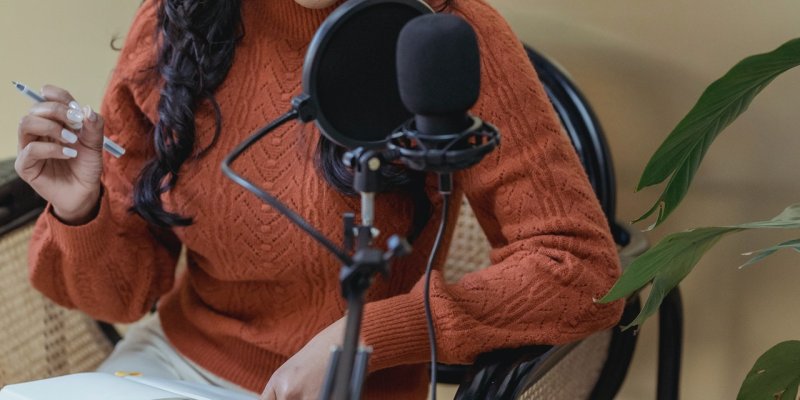
Both windscreens and pop filters are designed to stop a mic from picking up unwanted background noise, particularly noise from air pressure.
Mics pick up mouth noises, also known as plosives, that come from consonants we pronounce, like hard t's and p's.
Both tools can be used successfully to hide these noises and help the quality of your live or studio recordings. It's important to try to get rid of these mouth noises as best as possible when singing or speaking into your mic (Unless you're into ASMR mouth sounds).
Related Post: How Pop Filters Help Your Recording Process
Pop filters are designed to lessen noises from pops, wind, and clicks that come from our voices in studio settings.
They are most commonly made with foam and/or nylon mesh material and placed in front of a mic to filter out plosives. There are also metal pop filters that are sometimes preferred for more durability and visual transparency.
Pop filters are not used for live performance settings, so there is no need to buy one if your focus is not on recordings.
While pop filters do great for lessening the sound of plosives, they are not designed to block out background noise in general, especially if you're using an omnidirectional mic.
If you need to reduce background noise, consider soundproofing tools like window seal strips, noise-reducing curtains, and door stoppers that can help with noise coming from outside and other places in the house.
Also, be sure that your mic isn't picking up your AC/Heat and fans, which can be a huge source of background noise.
Windscreens can be used in studio performance settings, but they are designed for live performances where air pressure from weather and unwanted background noises can be filtered out from the mic.
Windscreens work best for outside setups where literal wind can easily be picked up by a microphone and negatively affect the sound of a performance.
They are made from a foam material and also protect the mic from dust, dirt, and other tiny elements that could get into the mic.
You may or may not have noticed this when hearing someone perform live using a windscreen: they also dampen the higher frequencies of your vocals, which can give your performance a warm or muffled sound.
This is one reason not to use windscreens in the studio, especially as a female vocalist.
It's important to note that while windscreens help with unwanted plosives, pop screens are a better fit for that particular use.
Clicks and pops from consonants, spit, and your tongue that have nothing to do with air pressure or wind will still come clearly through a mic with a windscreen. While pop filters don't completely stop these noises, they simply do a better job at trying.
Now that you have a good idea of what both can do for you, you may be asking yourself if you could use both at the same time in a recording studio setting. Many will say that this is overkill, but it's really up to your mic and your sound preference.
I've heard many singers say they use both due to having a very sensitive mic. I get very annoyed with mouth noises on my takes that I have to redo, but as a female singer, I cannot dampen the sound of my higher vocal frequencies, so I don't use both.
For podcasts or streaming, the warmth would be more welcomed.
If you're like me and need more help with plosives, try speaking a little bit further from the mic to lessen the presence of those unwanted sounds. Another tip is to smile while singing or speaking to avoid pops in your "b" and "p" consonants.
And my last tip that's a bit left-field, but it works: eat apples to get rid of mouth clicks! The acidic properties help with overly dry or overly wet mouth noises that mics pick up.
Related Post: Best Vocal Amps For Live Performances
So end the end, both pop filters and windscreens are useful tools for improving the quality of your recordings by minimizing unwanted background noise, specifically plosives or mouth noises.
Pop filters are commonly used in studio settings and are effective at reducing pops, clicks, and wind noise. They are not necessary for live performances and don't block out general background noise.
On the other hand, windscreens are designed for live performances and are particularly helpful in outdoor setups where wind can negatively impact the sound. They also offer protection against dust and dirt.
However, windscreens can dampen higher frequencies, giving a warm or muffled sound, which may not be ideal for studio use, especially for female vocalists.
While windscreens help with plosives related to air pressure, pop filters are more effective at reducing other types of mouth noises.
Remember to experiment with microphone placement, speaking distance, and even try eating apples to minimize mouth clicks. Ultimately, choose the tool or combination of tools that best suits your needs and sound preference.
As an Amazon Associate, Yona Marie earns from qualifying purchases. Amazon and other affiliate products are recommended to genuinely help readers and keep this site up and running as well.

As a session singer, writer, and producer that has worked with over 300 clients to provide high-quality jingles, singles, and features, Yona spends her time creating and marketing new music and helpful resources for creators. Check out Yona’s latest releases on her Spotify, her Youtube and share if you like it!
If you are in need of singer, songwriter or song producer services, see what Yona Marie can offer you on her services page.